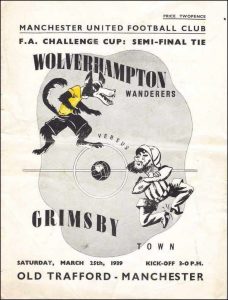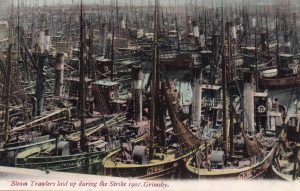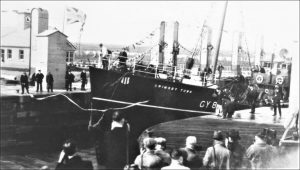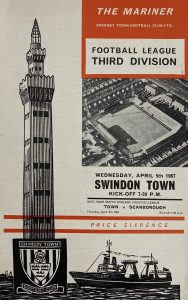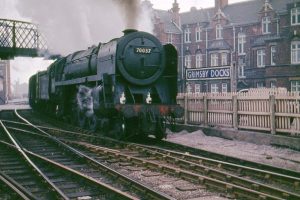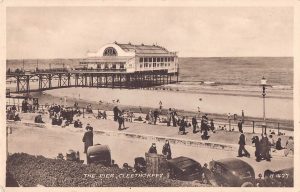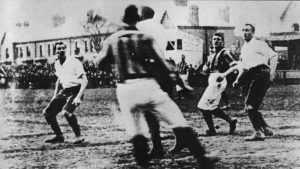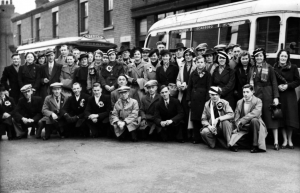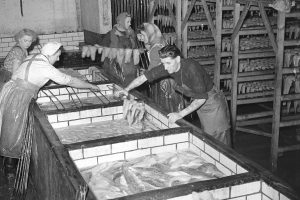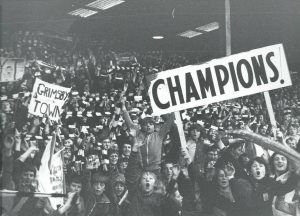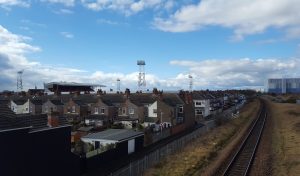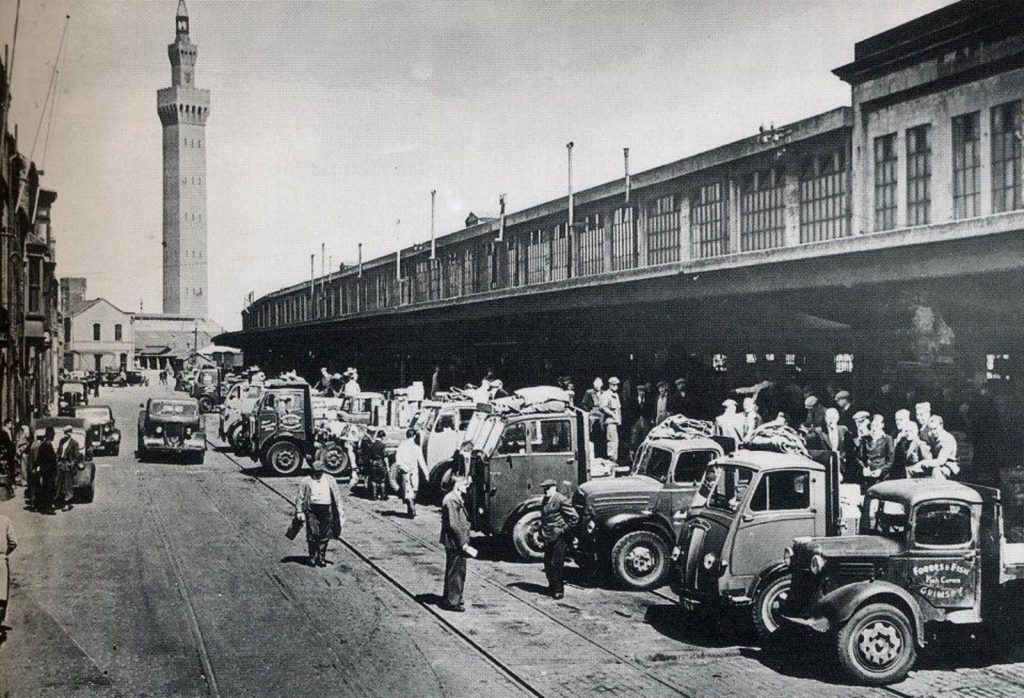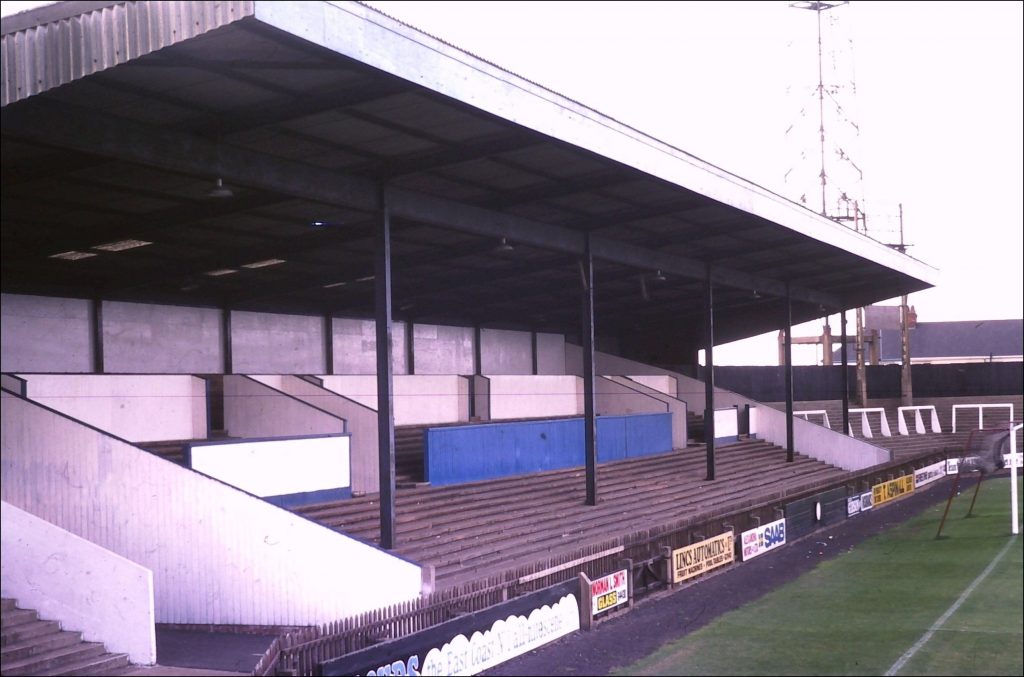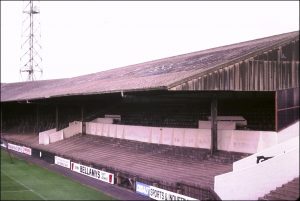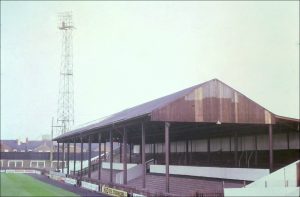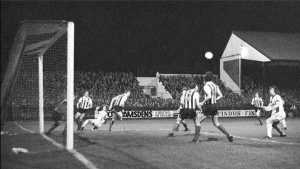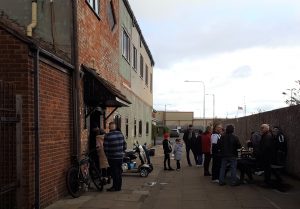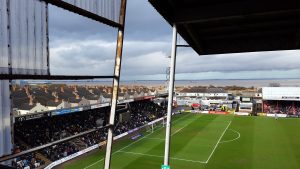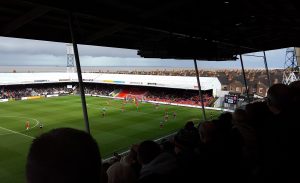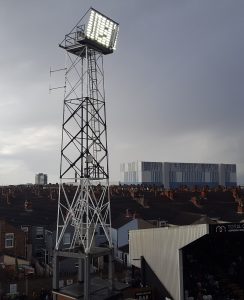Grimsby Town 1 Walsall 1
League 2
Saturday 25 March 2023

fishy business
The context
A long overdue trip to meet my Grimsby-mad friend David. I’d been promising him this visit for two seasons; now, designated driver Kieran and myself (along with some butter pies) were finally on our way.
The history
What does Grimsby immediately make you think of? Fish. By the mid-twentieth century this had become the world’s biggest fishing port. Two fish docks opened here between 1856 and 1877; another followed in 1934. Fast rail links allowed cod and haddock transported direct from the Docks goods yard to reach London’s Billingsgate Market within hours, and at their peak Grimsby’s five hundred trawlers generated a third of Britain’s entire fishing revenue.
Among them were some named after football teams. Consolidated Fisheries began this practice for deep-water ships during the 1930s; twenty-nine examples eventually entered service, with all except Real Madrid celebrating English sides. The Grimsby Town enjoyed a short but eventful career. Built in 1934 and requisitioned for Royal Navy use during World War Two, she was used for anti-submarine training and wrecked off the coast of Iceland shortly after being returned to her owners.
Grimsby’s mid-1800s Royal Dock (commemorating Queen Victoria and Prince Albert’s 1854 visit) was built to export coal transported from Yorkshire’s pits. Alexandra Dock, completed in 1880, further increased the port’s capacity. An ornate tower held water to drive its hydraulic entry gates; two railway stations, along with miles of sidings, supported import facilities that nowadays handle wood from Scandinavia, German-built Volkswagen cars and – ironically – Icelandic fish.
Of those stations only Grimsby Docks survives. Its junction with Fish Dock Road was once the busiest level crossing in Britain; today just one track operates. An ornate booking hall and miles of sidings have gone, while Grimsby Pier – which stood near the Dock Tower – is also no more. Thousands of emigrants from Europe to the New World once boarded Liverpool-bound trains there, while other rail passengers travelled eastwards towards Hamburg.
The neighbouring seaside town of Cleethorpes prospered too. Tourists – attracted by its pier, promenade and bracing air – flocked from industrial Yorkshire. A terminus station opened at one end of the newly-extended Manchester, Sheffield and Lincolnshire Railway line from Grimsby, separating beach from expanding northern suburbs. Respectable streets stealthily merged both boroughs so that their dividing line became invisible; nearby, in 1899, Grimsby Town built Blundell Park.
Abbey Park had been their previous home. This substantial ground lay near People’s Park and was bounded by present-day Legsby Avenue, Park Drive and Welholme Road. They brought two stands with them. First Division football soon followed, but Grimsby’s subsequent history has mostly featured second and third tier competition punctuated by occasional forays into obscurer territory. Ten of their twelve top flight seasons came between 1929 and 1948.
That era also brought two FA Cup semi-final appearances. Town could count themselves unlucky in 1936, losing to Arsenal by a single goal at Huddersfield. Their 1939 game against Wolves – where goalkeeper George Moulson was injured early on – ended 5-0, but attracted Old Trafford’s biggest ever crowd of just under 77,000. Another Cup-tie with Wolves two years previously had set Blundell Park’s impossible-sounding 31,000 attendance record.
Grimsby’s successful team even had a railway locomotive named after them. No.2850 Grimsby Town was one of the LNER’s B17 or “Footballer” class, designed by Sir Nigel Gresley. It entered service during 1936 and hauled passenger trains between London and East Anglia for twenty-two years. One nameplate can now be seen in Blundell Park’s Alan Buckley Lounge: the other is at the National Railway Museum.
The modern docks and town have an undeniable air of decay. EU quotas decimated their trawler fleet, while newer enterprises – such as food processing and frozen seafood – could never employ anything like equivalent numbers. Fishing had defined local life for two centuries; entire families were once employed cleaning, gutting and packing the catch, while even children found work untangling nets. Now nothing remains.
Viewed in this context Grimsby Town (back in League football after a brief and surprising absence) appear reassuringly constant. They have often defied overwhelming odds; resilience comes with the territory, so too does fierce local pride. Outsiders underestimate both at their peril.
The journey
Simplicity itself. M6, M61, M60, M62, M1; sausage, bacon and egg butty at Woolley Edge, meet Kieran near Rotherham, traverse some flat Lincolnshire motorways. There wasn’t much traffic and we arrived soon after midday. Our return journey – interrupted only by a brief and welcome detour to swap the pies for cans of stout from David’s van – went equally well. I would be back in my local by seven-thirty that night.
The ground
A tall stand towers above neighbouring streets. Frozen fish company Findus contributed half the building costs; it was first used against Leeds United on 28 August 1982. This occasion went badly wrong as 8,000 visiting fans pillaged Cleethorpes, also causing extensive damage to Blundell Park. The stand provides fine views – of pitch, Humber estuary and passing ships – but can be devilishly draughty.
- Pontoon (Grimsby Telegraph)
- Pontoon (Bob Lilliman)
There has always been a Pontoon End here. The first (named after Grimsby’s main trawler berth) dated from 1899. Two other early stands – Abbey Park and Hazel Grove – originated at Abbey Park. They would be eventually replaced by the Barratt and Osmond stands, named after sympathetic Council officials from Town’s inter-War boom years. Today’s seated Pontoon features new concrete steps beneath its refurbished 1960s roof.
The Osmond has been similarly converted. This end previously featured ramshackle seating surrounded by wooden terraces; one fenced-off section survives between here and the Main Stand. The Football League’s oldest surviving structure was extended following Grimsby’s 1980 promotion under George Kerr (these improvements seem to have started an irrational fondness for red seats, which now fill three sides of Blundell Park).
Adding Findus and Main Stand paddock seats cost 8,000 terrace places. For many fans things would never be the same. Their old ground – wooden steps, low claustrophobic roofs and all – could be intensely loud for big games. The old Barratt was particularly missed; its apogee came during Town’s League Cup game against Everton in 1979. a raucous night when over 22,000 saw them win 2-1.
As one recalls on thefishy.co.uk :
Best night in the Barratt? The Everton game without a doubt. Their players came out an hour before kick off and the place was jam packed. We could see them in the tunnel before anyone else, and as they came out in their suits the roar that went up from the Barratt was echoed round the ground. It was a spine-tingler. They looked totally shell shocked and the crowd just chanted the whole time. No stupid songs, no stupid drum, no stupid band, just real chants from the throats of real fans. Everton were beaten before kick off.
Blundell Park holds out bravely against Sky-era sanitisation. Even so, much has gone; no more trawler goal-nets, corner terraces flattened, the Imperial Hotel now flats, four magnificent floodlight pylons – acquired from Wolves in 1958, where they illuminated famous exhibition games against Honved, Real Madrid and Moscow Dynamo – shamefully lopped. The Art-Deco Ritz cinema that once fronted Grimsby Road was pulled down and replaced by a McDonalds. Filet o’Fish anyone?
Flesh and wine
Kieran parked on Harrington Street. This spot – midway between ground and fish dock – proved handy for the Rutland Arms, a curiously elongated, mostly windowless backstreet boozer that despite its derelict appearance proved full of match-goers. After slaking our thirst we checked out the Blundell Park Hotel, where what time remained before kick-off was spent with two stray Hull fans and various other locals who had clearly been in there since breakfast-time.
Fish and chips seemed too obvious so I bought a pie beneath the erstwhile Findus Stand. This angular construction feels cramped underneath – all narrow steps, unexpected swing doors and hidden corners. Once you reach the top tier there’s little incentive to go back down again before full time. (It was good pie but clumsy handling meant the men in front nearly ended up wearing peas and gravy.)
The game
Rain showers gave way to sunshine. Although this was your classic mid-table affair, Grimsby – in significantly better form – started out like men possessed. George Lloyd and Niall Maher both tried pot shots following Danny Amos corners; another such ended with Bryn Morris walloping Grimsby’s opener from outside the box. A John McAtee free kick might well have doubled their lead, while at the other end Conor Wilkinson shot wide when scoring looked easier.
Walsall grew more confident and continued pressing after half time. Donervan Daniels equalised but it didn’t look pretty, a proper Pinball Wizard job that ended up bouncing into the roof of Grimsby’s net. And so things stayed. McAtee came close again, as did Daniels; what thrilled everyone most, however, was the passive-aggressive fracas that followed Andy Smith’s foul on visiting ‘keeper Owen Evans. We don’t want to see that sort of thing, do we?
Teams and goals
Grimsby: Crocombe, Waterfall, Maher, Efete, Morris, Green, Amos, McAtee, Lloyd (Khan 85), Taylor. Unused subs: Emmanuel, Clifton, Hunt, O’Neill, Orsi, Khouri.
Walsall: Evans, Riley, Daniels, McEntee, Monthe, Kinsella, Comley (White 45), Maddox (Williams 45), Hutchinson, Knowles, Wilkinson (Stevens 86). Unused subs: Smith, James-Taylor, Allen, Songo’o.
Goals: Grimsby: Morris 18. Walsall: Daniels 50.
Attendance 7146.
